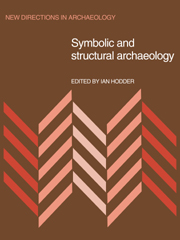Book contents
- Frontmatter
- Contents
- List of contributors
- Preface
- Part one The development of theory
- Part two The search for models
- 5 Matters material and ideal
- 6 House power: Swahili space and symbolic markers
- 7 The interpretation of spatial patterning in settlement residues
- 8 Decoration as ritual symbol: a theoretical proposal and an ethnographic study in southern Sudan
- 9 Structures and strategies: an aspect of the relationship between social hierarchy and cultural change
- 10 Mortuary practices, society and ideology: an ethnoarchaeological study
- Part three Application: the analysis of archaeological materials
- Part four Commentary
- Index
10 - Mortuary practices, society and ideology: an ethnoarchaeological study
Published online by Cambridge University Press: 27 February 2010
- Frontmatter
- Contents
- List of contributors
- Preface
- Part one The development of theory
- Part two The search for models
- 5 Matters material and ideal
- 6 House power: Swahili space and symbolic markers
- 7 The interpretation of spatial patterning in settlement residues
- 8 Decoration as ritual symbol: a theoretical proposal and an ethnographic study in southern Sudan
- 9 Structures and strategies: an aspect of the relationship between social hierarchy and cultural change
- 10 Mortuary practices, society and ideology: an ethnoarchaeological study
- Part three Application: the analysis of archaeological materials
- Part four Commentary
- Index
Summary
Recent accounts of the investigation of social organisation as reflected in mortuary practices have been based on role theory. If the notion of roles is deemed to be part of an inadequate conception of social systems, then it is necessary to reconsider existing archaeological approaches to burial data. Burial ritual is susceptible to ideological manipulation within the construction of social strategies. An analysis of mortuary practices in modern and Victorian England leads to an interpretation both in terms of the way the dead are seen by the living and in terms of the social relationships between competing groups. Since the Victorian era when burial ritual was a forum for the display of wealth and status, the dead have come to be seen more and more as unwanted matter to be disposed of quickly, without extravagance. This development, involving changes in the use of cremation and in the physical traces of the burial, is part of the increased use of hygiene, science and medicine as agencies of social control, and is related to a decrease in the use of conspicuous wealth consumption for social advertisement. Finally, a series of general propositions are advanced concerning the study and interpretation of mortuary practices.
Introduction
In the last ten years there have been many developments in the reconstruction of past social systems from the material remains of mortuary rituals. There have been several attempts to provide linking principles between the material culture associated with mortuary practices and the form of social organisation (Saxe 1970; Binford 1972; Brown 1971; Shennan 1975; Goldstein 1976; Tainter 1977; Peebles & Kus 1977).
- Type
- Chapter
- Information
- Symbolic and Structural Archaeology , pp. 99 - 114Publisher: Cambridge University PressPrint publication year: 1982
- 171
- Cited by



